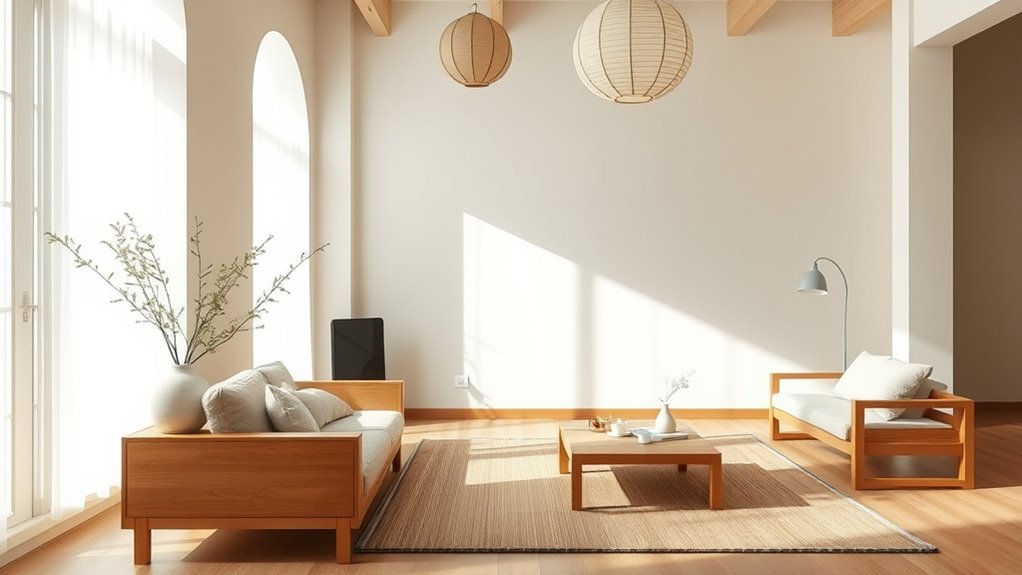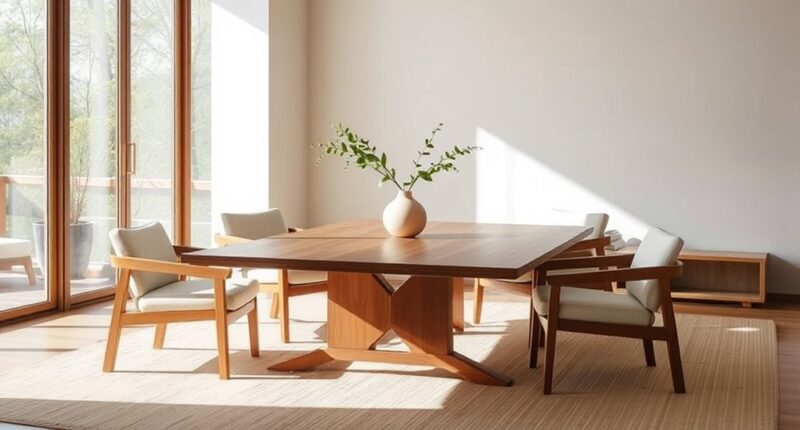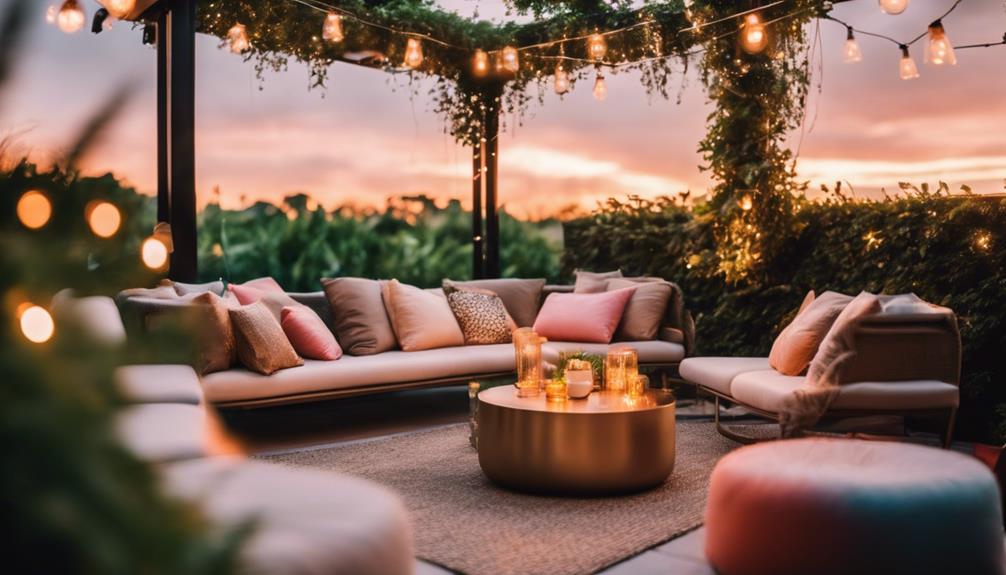Japandi style merges Japanese minimalism with Scandinavian coziness, creating spaces that are serene, functional, and inviting. You’ll find clean lines, natural materials, and a neutral color palette that foster tranquility and balance. This approach emphasizes simplicity, craftsmanship, and eco-friendly choices to promote well-being. By focusing on purposeful design and minimal clutter, you can craft a timeless, harmonious environment. Explore further to discover how these principles can transform your space into a peaceful retreat.
Key Takeaways
- Japandi style combines Japanese minimalism with Scandinavian coziness, emphasizing simplicity, functionality, and tranquility in interior design.
- It utilizes natural materials like light wood, stone, and textured fabrics to create warm, sustainable spaces.
- The color palette features subdued neutrals such as beige, taupe, and soft gray, complemented by ample natural lighting.
- Furniture is simple, high-quality, and functional, with accessories kept minimal yet meaningful to foster calm.
- This design approach promotes a balanced, timeless aesthetic that enhances well-being and offers a serene retreat from chaos.

Japandi style seamlessly blends the minimalist elegance of Japanese design with the cozy simplicity of Scandinavian décor, creating a harmonious aesthetic that emphasizes functionality and tranquility. When you embrace this style, you’re adopting a look that’s both sleek and inviting, where every piece serves a purpose and contributes to a sense of calm. Central to Japandi’s appeal is its focus on minimalist aesthetics. You’ll find that clutter is kept to a minimum, with clean lines and open spaces dominating your environment. This simplicity is not about starkness but about intentional design choices that highlight the beauty of each element. The aesthetic relies on a pared-down approach, where unnecessary ornamentation is eliminated, leaving only what truly matters. This allows the natural flow of energy through your space, fostering a sense of balance and serenity.
Natural materials play a pivotal role in achieving the authentic Japandi look. You’ll want to incorporate materials like light-colored woods, stone, and textured fabrics that emphasize the beauty of nature. These materials bring warmth and tactile comfort, contrasting beautifully with the sleek, minimal forms. For example, a coffee table crafted from smooth, pale wood or a linen throw in muted tones can instantly elevate the space while maintaining the style’s understated elegance. Using natural materials also aligns with the principle of sustainability, making your décor eco-friendly and timeless. They age gracefully, developing character over time, which reinforces the enduring appeal of Japandi design. Incorporating high-quality craftsmanship is essential, as it elevates the overall aesthetic and ensures durability.
When you curate your space in the Japandi style, pay attention to the harmony between these elements. Keep your color palette subdued, favoring neutral shades like beige, taupe, or soft gray. Let natural light flood your rooms, enhancing the organic feel and highlighting the textures of your chosen materials. Furniture should be simple yet functional, with a focus on craftsmanship and quality. Each piece should have a reason for being there, contributing to the overall sense of peace. Accessories are kept to a minimum but can include a few carefully selected items like ceramic vases or woven baskets that add subtle texture and personality. By blending minimalist aesthetics with natural materials, you create a space that not only looks beautiful but also nurtures your well-being, offering a retreat from the chaos of everyday life.
Frequently Asked Questions
How Do I Incorporate Japandi Style Into a Small Space?
You can make a small space feel cozy and stylish by choosing space-saving furniture that maximizes your area without clutter. Keep the decor simple with clean lines and neutral tones, adding subtle decorative accents like textured throws or minimalist art. Incorporate natural materials such as wood or bamboo, and maintain an open, airy feel. This approach aligns with japandi principles, blending functionality with serene aesthetics effortlessly.
What Are Common Color Schemes Used in Japandi Décor?
Did you know that 75% of interior designers favor neutral tones for creating calming spaces? In Japandi décor, you’ll often see these neutral tones paired with earthy hues, which foster a serene and welcoming atmosphere. Think soft beiges, warm grays, and muted browns. These color schemes emphasize simplicity and balance, helping you achieve a harmonious look that blends Japanese minimalism with Scandinavian coziness effortlessly.
Is Japandi Suitable for Both Modern and Traditional Homes?
You might wonder if Japandi suits both modern and traditional homes. The answer is yes, because it combines traditional charm with contemporary appeal. This style’s minimalist, clean lines fit well in modern spaces, while its warm, natural elements add coziness to traditional homes. You can adapt Japandi to your home’s character, blending simplicity with comfort, making it versatile for various styles and preferences.
How Can I Balance Minimalism With Coziness in Japandi Design?
Imagine a serene garden where minimalism is the clear, open sky, and coziness is the lush, inviting greenery. To balance these in your space, incorporate cozy textures like soft throws or plush rugs, blending seamlessly with functional simplicity. Keep furniture sleek and uncluttered, but add warm elements that invite touch and comfort. This harmony creates a calm, inviting environment where less truly feels like more, without sacrificing warmth.
What Are Affordable Ways to Achieve Japandi Aesthetics?
To achieve japandi aesthetics affordably, focus on using affordable furnishings that highlight clean lines and natural materials. Incorporate DIY decor projects like handmade ceramics or simple wood accents to add warmth and personality. Thrift stores and online marketplaces are great for finding budget-friendly pieces. Keep your space uncluttered and balanced, blending minimalism with cozy touches, so your home reflects the serene, elegant vibe of japandi style without overspending.
Conclusion
By blending Japanese minimalism with Scandinavian coziness, you create a space that’s both calming and stylish. Japandi style encourages you to embrace simplicity without sacrificing comfort, making your home a true sanctuary. Are you ready to transform your space into a harmonious retreat that reflects both worlds? With just a few thoughtful touches, you can achieve a balanced, elegant look that feels uniquely yours. Isn’t it time to bring this serene fusion into your home?









